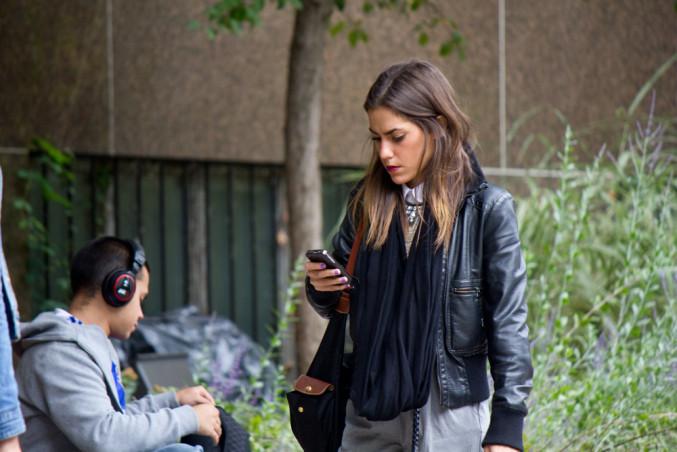By Astoria Luzzi & Carolyn Turgeon
Walter Pitman craved a dialogue with his students. In the late ’70s, he would leave his office and wander around campus, interacting with students and finding out how they felt about their life at what was then called the Ryerson Polytechnical Institute of Toronto.
Pitman is remembered as a Ryerson president who had an open-door policy. He had times of the day set aside during which you could just walk into his office and talk to him, remembers Brian Lesser, director of Computing and Communication Services (CCS). Now more than 30 years later, technology and social media allow the student body to connect with all sorts of people with all sorts of power at any time of the day.
“Twitter can level things and allow you to see people as people, if used well,” said Lesser.
“[You] have a little bit of a personal dialogue with them in a way that you couldn’t really before.” Lesser’s boss, Julia Hanigsberg, is a current example of how Ryerson administrators can connect students on a more personal level.
As vice president administration and finance, Hanigsberg spends a lot of time in her Jorgenson Hall office, dealing with matters that affect the university as a whole but usually don’t require a lot of face time with students.
Hanigsberg uses Twitter as a way to participate and communicate in social circles that are part of her work and personal life, and all in a professionally appropriate manner. With 1,359 followers and 7,373 tweets, Hanigsberg tweets and responds to fellow users about Ryerson and higher education, life with her family and her own interests.
From his office in the basement of Jorgenson Hall, where there are no obvious windows and little to no student traffic, Lesser also uses Twitter as a way to communicate with students since his role in CCS includes making sure the campus’ wireless internet service is running smoothly.
In this past February, there was a lot of congestion and connection issues in the Library and George Vari Engineering and Computing Centre buildings. CCS was aware of the problem, but not of the severity, until Lesser came across complaints from several students posted on Twitter. “What I’ve started doing is just going on Twitter and searching Ryerson or Ryerson Wi-Fi,” he said. “To my shame, sometimes I find out about problems on Twitter sooner than I do from our own staff.” Upon realizing the effect the congestion was having on students, CCS posted on their blog alerting the Ryerson community of which areas and buildings were experiencing the outages.
CCS immediately began planning to add more Wi-Fi access points throughout campus.
This effort continued through the summer months and into September. During this time, the original service alert on the blog was updated periodically with every improvement, an effort that wouldn’t have started as quickly if not for the student feedback collected through social media.
CCS informs the university of major outages and problems with campus Wi-Fi and online services by sending out mass emails through the RMail system and posting messages on Blackboard. Ryerson Security and Emergency Services have recently adopted the same method of communication, which they announced in their first email to the campus community last Thursday.
“It was a suggestion from the emergency [task force], as well as our department recognizing the need,” said Tanya Fermin-Poppleton, manager of security and emergency services. “It was a long time in the process of discussions.” The first email explained that the Security Watch alerts, usually printed and posted around campus, are now going to be sent straight to inboxes and posted on Blackboard.
“What we’re hoping is that more students will be aware of what’s happening on campus, faster than how they were before,” said Fermin-Poppleton. “This just gives everybody an opportunity to see it all at the same time, and hopefully more people [will take notice].” However, students will have the opportunity to opt-out of these security alerts on Oct. 8. Even if they don’t opt-out, there is no guarantee that students will be taking in the information. “I rarely read them. I see them as junk mail,” said Jeraldyne Pallara, a first-year biology student. “Maybe if they used social networks such as Twitter or Facebook I would read about things they need to let students know.” Fermin-Poppleton says there have been discussions on using social media such as Facebook, Twitter and even text alerts, but she has no estimate as to how or when those ideas will be implemented.
An average-sized university such as Ryerson can not stick to one avenue of distributing information, according to Restiani Andriati, manager of Ryerson’s Digital Media Projects Office (DMP). The DMP’s role is to support instructors in learning how to incorporate social media and technology in the classroom.
Andriati feels that schools, including Ryerson, have to maintain a presence on multiple platforms in order to keep the community well informed. “I don’t think everyone is off email, so if you [use it you’ll] catch a percentage of people,” she said. “If you want to reach as many people as possible then you use as many
[avenues] as possible.” Lesser is aware that a portion of the Ryerson population does not bother reading the mass emails. He drew attention to the fact that just because the university email is traditionally seen as the official method of contact, it does not necessarily mean it is the only one.
“There is no [one] way to reach out to 30,000 people,” he said.
Ryerson University’s official Twitter (@ RyersonU) and Facebook page both link to media articles about the university as well as to their own website and Ryerson Today, the school’s online newsletter. All of the links on the Facebook page are also posted on the Twitter account. There is minimal interaction with other site users, with occasional retweets of Ryerson-related content and extremely rare replies to the many students tweeting at or about them. The account is managed by the Office of University Advancement, but different departments contribute. The Ryerson Facebook page allows students to contribute with posts, but again there is minimal interaction between the page and its commenters and visitors.
At the Ontario College of Art and Design University (OCADU), there has been a growing trend among students using Twitter and Facebook to ask the university questions about anything from admissions to deadlines to where to find certain information. “They’re using it as a primary communication tool beyond calling us or emailing us,” said Sarah Mulholland, media and communications officer in OCADU’s marketing and communications department.
She doesn’t like the idea of putting the same content on both streams, the method Ryerson uses. Using the resources the sites offer, she feels that Facebook content should be richer due to the ability to embed pictures and videos and provide longer content, while Twitter is short-form and requires summarizing your content to make it fit.
“I think you need to tailor the information for the environment that it’s in,” said Mulholland.
“I actually custom message them.” Gord Arbeau, director of public and communications at McMaster University, agrees that platforms should not be treated the same, and that tweets should be approached like a headline for the linked content. Facebook, in his opinion, is primarily questions, participation and engagement. Brock University is a few steps ahead in terms of social media. Not only are their Facebook and Twitter pages very active, with differentiated content and plenty of interactions with students, but they’ve actually created a social media co-ordinator position on staff.
Jocelyn Titone, the current co-ordinator, “monitors and tracks online ‘buzz’ about Brock, manages the University’s social media presence (blogs, communities, Facebook, Twitter, YouTube, etc.) [and] provides social media training for faculty and staff,” according to their website. On their accounts, she can be observed helping and communicating with students about a range of topics.
Brock also has social media guidelines on their website to instruct faculty, staff, students and alumni on using these tools. They advise on how to “always be upfront and honest about who you are and what you represent, use common sense before you post or comment, and respect the values and etiquette of communities you join.” Their guidelines incorporate other Brock standards, including their Respectful Work and Learning Environment Policy, their Access to Information and Protection of Privacy Policy and their Institutional Brand Identity Policy.
In general, the guidelines are about using social media as a representative of Brock, but can also be used to guide a student or faculty member’s personal or hybrid use of such websites.
According to Jeffrey Sinibaldi, media relations officer at Brock, “They are policies that were developed by Jocelyn and her predecesors.” OCADU is taking steps in the same direction.
They are in the process of putting together a formal social media policy and creating a position for a full-time social media officer.
“Right now [the social media work] is about half my job,” said Mulholland. “I work in the Communications department and also take care of media relations, so one of the ideas is to split the position in two.” The newer role will involve coming up with policies to help with the social media environment and provide strategies for the university.
“We have some great ideas and some guiding principles but really nothing published about that,” Mulholland said.
Ryerson, however, lacks a concrete policy on the subject. “The university has [constructed] a commitee and social media policies [are] in development,” said Suelan Toye, media relations officer for Ryerson University.
Currently, the closest thing related to a policy would be a section in the Legal and Policy Issues in the Human Resources section of the Ryerson site. “Social Media Use – The Employee Dilemma” is just a written blurb about how using social media on your own time can still affect work life. There are no actual rules or suggestions, other than the vague notion that this is a difficult balance and employees should keep it in mind. It concludes with the promise that “these issues will be considered starting this fall, so that the University can provide appropriate guidance to employees to prevent these kind of problematic situations.” Andriati explained that when the DMP helps faculty members, they have a checklist of things that they should consider when adapting social media tools for learning purposes.
“Policies should be transferable,” said Andriati of the other Ryerson guidelines in place.
“If you’re following the guidelines that are already in place, that would permeate in your online behaviour as well.” However, she did not specify what policies would transfer over, and the only policies on the website concerning student behaviour are the Student Codes of Academic Conduct and Non-Academic Conduct. These policies cover plagiarism, cheating and non-school matters, but make no mention of social media guidelines.
In order to properly advise members of the university on social media matter, an actual policy and guidelines are necessary.
“Ryerson could use some policies and some guidelines for people like me,” joked Lesser on his use of Twitter. “I know the etiquette and maybe I forget it sometimes but most of the time I’m good.”










Leave a Reply